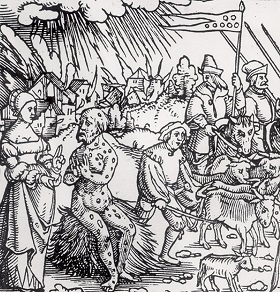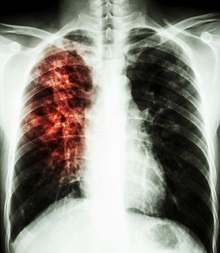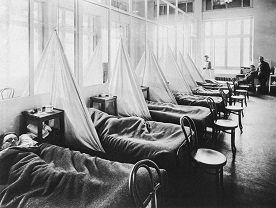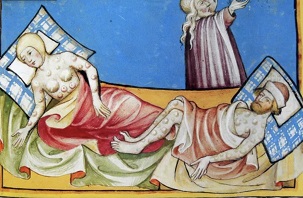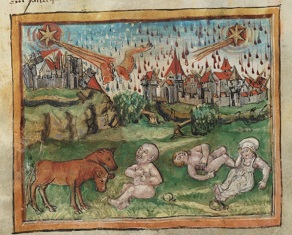The Pandemic Myth: The world is a much safer place than you're told
John Varoli
History is clear -- major outbreaks of disease only follow wars and/or sudden climatic cooling periods that lead to famine. We have none of this today. So, how can Covid be a 'pandemic'?
If microbes truly are deadly — as bumbling government bureaucrats and greedy Big Pharma execs tell us — then there should be pandemics every year. Humans should be dropping like flies, on the verge of extinction. But we’re not. Why?
No matter how much we sanitize our hands and bodies, the fact is that over 400 trillion viruses exist in each of us, and trillions more are in the air, water and surfaces around us. In addition, the Earth is home to millions of distinct viral species, as well as bacteria. In short, the microbial world is the most dominant life vector on Earth. I could easily argue that we live on their planet. And we’re simply their hosts. Thus, microbes have a vested interest in keeping us alive.
But what about a pandemic? It’s a major killer, right? Not so fast. As a purely natural phenomenon, a ‘pandemic’ is extremely rare. In fact, I can argue that pandemics don’t really exist, and anyone trying to scare you about the “next pandemic” is a wicked rogue and charlatan.
The scientific data and evidence is clear — major outbreaks of disease only follow wars, famine, social upheaval or a sudden climatic cooling that weakens one’s body and immune system. There’s never been a natural mass outbreak of disease during a time of peace and prosperity, such as the era we’ve been living in for 30 years.
As long as you’re well fed and housed, with access to clean water and air, and not facing the scourge of war and physical abuse, and not under great stress, then chances are that until you turn 65 years old, you’ll never get an infectious disease worse than the typical winter cold. Yes, as you age and reach your senior years, your body eventually breaks down. Sorry Folks, death is inescapable. The good news, however, is that for most of your life, you won’t need to have an irrational fear of ‘pathogens’
My work on the frontlines
In the early 1990s, while in my mid 20s, I worked as an NGO director in Moscow helping refugees and the homeless. In total, I spent four years on the front lines of what was the (antibiotic-resistant) Tuberculosis epidemic, one of East Europe’s most deadly post-1945 events.
Despite gloomy apocalyptic forecasts, that highly contagious airborne TB never went global, and almost all its victims were people on society’s margins. I saw with my own eyes how the pathogen almost always sickened people already weak from poor social conditions such as years in prison, alcoholism, drug use, poor diet, hunger and overall poverty and psychological and spiritual despair.
Even though I had close contact with the TB infected almost every day, I never became ill, and I never tested positive for TB. How is that possible? Well, I was young, in good shape, in good spirits and observed basic hygiene.
My years with the infected allowed me to conclude that our understanding of the microbial world is very wrong. Viruses and bacteria are not killing machines. Rather, these microbes are the essential building blocks of life, and without them life on Earth wouldn’t exist.
Global or regional pandemics in recorded history
Recently, I went back to the history books to research major disease outbreaks over the past 1,500 years. I excluded seasonal appearances of the flu, which primarily takes the lives of those who are at the end of their natural life cycle. I was more interested in the question — have there been outbreaks of disease that mercilessly strike at all segments of the population?
Only three times in history has there been a mass killing of all segments of the population across a very wide geographical area: The Bubonic Plague (1349-51); the 16th century Spanish conquest of the Americas; and the Spanish Flu (autumn 1918).
In my last post, I debunked the false narrative for the 1918 Spanish Flu. Symbolically, I spent 18 months researching that topic. If you haven’t yet read that article, then I’ll repeat my main findings — despite what you’re told, the Spanish Flu in fact only lasted about two to three months in autumn 1918. The Spanish Flu didn’t last two years, as the government and Big Pharma wants you to believe.
My research also made clear that the Spanish Flu killed about 10-12 million people; not 100 million as we’re told. Many of the Flu dead were young men, especially soldiers in their prime, who were living in absolute filth and squalor, and who were deathly frightened by the thought of going to fight at the front.
The young felt the brunt of World War I’s physical and psychological devastation, so we can speculate that this led to a greater inclination toward disease. Again, it’s peculiar that the Spanish Flu occurred in the final months of World War I during major military offensives. We all know what a leading role stress and fear plays in disease and illness.
Overall, World War I’s violence, hunger and deprivation, along with harsh and wet weather, had brought most of the world’s population (civilian or military) to the brink of life and death. Had there been no world war, there’d be no Spanish Flu. It’s that simple. Wars and social upheaval are caused by people. Don’t blame Nature. Don’t blame God.
The next big mass killing of humans came with the Spanish conquest of the Americas in the 16th century. Smallpox and other European diseases devastated indigenous peoples. But again, if we take a closer look, we see that the disease outbreak followed war and massive social upheaval. Think of the stress that people face when invaded and are hunted, fighting for their survival.
The standard theory is that the Spanish introduced smallpox, measles, influenza, typhus and yellow fever, which had a major impact on Maya, Aztec and other native populations. But we are never told that the South American jungle also had dangerous ‘pathogens’ of its own, which should have wiped out the Spanish invaders. But of course, that didn’t happen.
For example, a native disease, named Cocoliztli by the Aztecs, caused many deaths among both locals and the Spanish invaders. There were several major outbreaks, and the disease bewildered both native and Spanish doctors. Again, no surprises here. This was a time of turmoil — warfare and social dislocation. If there had been no war or social collapse, then there’d have been no mass outbreak of disease whether or not it was local in origin or imported from Europe.
Bubonic Plague (Black Death) — a similar pattern, but with a twist
Bubonic Plague, known scientifically as Yersinia pestis, and more commonly as the Black Death, has been with us for thousands of years. You’d think that in that time, most humans and their offspring would have developed immunity to it. Right?
Now, here’s where things get really interesting. A closer look at the Black Death in the mid 14th century reveals no conclusive evidence as to what caused this tragedy. No one can say for certain it was a bacterial pathogen. In fact, a growing body of evidence indicates that the main factor leading to the Plague was in fact a sudden climatic cooling that led to widespread crop failure and subsequent starvation.
The 40 years before the Plague were a time of global cooling that lead to devastating famines that killed millions of people as early as the 1320s, a full 25 years before the Plague even struck. In the famine years of 1315 -1320, an estimated 30% of Europe’s population was wiped out. Never heard of that, did you? The crop failure followed natural disasters that resulted from cool and wet summers.
By the time the Yersinia pestis bacteria allegedly appeared in 1348, Europeans were already starving, debilitated and weakened. To make matters worse, the three years immediately before the Plague were marked by massive crop failures caused by cold and wet summers. Yersinia pestis merely overwhelmed a human population that was barely hanging on by a thread.
In addition, there’s evidence for widespread meteor/comet strikes across Earth in that period. Medieval chronicles of the first half of the 14th century are full of references to “fire from the sky”. Could the Earth have been pounded by a passing comet that broke up and caused multiple impacts across the planet ? The amount of dust kicked into the air would cool Earth’s temperature, in turn leading to many deaths across the planet and giving the appearance of a biological ‘pandemic’ with people rapidly dying.
This theory got a boost in 2009 when, pointing to a reduction in tree ring growth in the mid 14th century, scientist Mike Bailey concluded that comets played a major role in precipitating the Black Death by causing a global adverse climatic event. He says a comet was seen over Paris in August 1348, just on the eve of the Plague. (See image below).
Swiss historian Sacha Dobler goes even further and concludes that the Black Death is the result of “a cold spell that ushered in the Little Ice Age, as well as meteor activity, earthquakes, decreased sun spot activity, crop failure, agricultural collapse, famine, and wars…” (“Black Death and Abrupt Earth Changes in the 14th century”; 2018)
One final thought on ‘pandemics’
I spent many months, if not an entire adult lifetime gathering the above information and observations. In conclusion, with much certainty, we can exonerate bacteria and viruses from false accusations of being Nature’s “killing machines”. Disease is to a large extent a product of our environment, and eradicating it depends heavily on the extent to which we can observe proper hygiene, keep ourselves properly fed, with clean air and water, well sheltered, stress-free and in good spirits.
Also, avoid dangerous chemicals and other artificial toxins that businessmen want to inject into you. I haven’t even begun to discuss this topic. But I think such ‘poisoning’ is a major contributor to ‘disease’.
Why is all of this important? Well, these scientific facts puts control for our life and fate back into our own hands. We no longer have to go about cowering in fear that a ‘deadly pathogen’ is lurking on every street corner. Standing close to someone, touching a dirty door knob or shaking hands won’t lead to your untimely death, and riding and breathing in the subway won’t soon end your life. And of course, you don’t need to wear a mask, which of course is absolutely pointless.
When we are empowered with Knowledge and Science, we can more easily avoid falling victim to the corporate and government charlatans and fear-mongers who want to scare us about the ‘next big pandemic’. As long as they don’t ‘juice up’ and create any super-virus in the lab, there won’t be a pandemic. But alas, that’s the problem. I can’t guarantee you that they won’t try to do that.
____________________________________________________________________________________________
Source: John's Newsletter (Substack). AWIP: http://www.a-w-i-p.com/index.php/aI4N

























